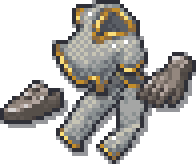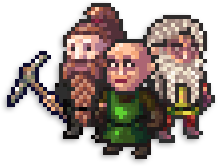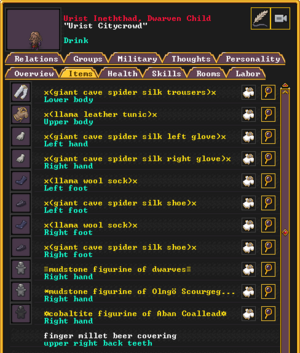- v50 information can now be added to pages in the main namespace. v0.47 information can still be found in the DF2014 namespace. See here for more details on the new versioning policy.
- Use this page to report any issues related to the migration.
Clothing
v50.12 · v0.47.05 This article is about the current version of DF.Note that some content may still need to be updated. |
- For making clothes, see Textile industry
- For clothing coverage, see Armor#Types of Protection
Clothes are items made out of cloth or leather, and worn and owned by sapient creatures. The availability of specific articles of clothing varies by civilization; each has its own set of clothing that it can produce. For example, in Fortress mode, sandals and shoes are in the same clothing class, but only the latter can be produced by dwarves, whereas the former must be stripped off dead enemies. Dwarves are gender-insensitive; a male dwarf may well put on a dress.
Within the game engine, there is no fundamental difference between clothing and armor, something accentuated by regular clothing's ability to occasionally block attacks. Clothes wear out over time. Some wearable leather items, including leather armor, helms, and boots truly are armor and will not be worn by civilians. Armor can be thought of as metal clothing, thicker and have a much better chance of blocking attacks. However, armor is not subject to standard wear and will not be automatically equipped by civilians. For details on specific items of clothing and their materials, see: Armor#Material_requirements.
Though many creatures, including non-humanoids, can wear all kinds of clothing, it is only dwarves, humans, elves, kobolds and goblins that will visually appear wearing different articles of clothing. This is because those aforementioned races have dedicated sprite sheets for each of them. While other creatures can wear clothes, it won't appear on their sprite, but clicking on them and checking their inventory can show they are wearing something, even if it wouldn't make sense in real life.
Uses
The primary reason civilians wear clothing is for modesty, see the thoughts section below for details. Some dwarves will also need to be extravagant, so clothing with quality or decoration bonuses will satisfy that. A particular benefit of footwear is to keep your dwarves from stepping barefoot in contaminants that can be dangerous.
Due to the multiple value modifiers that can apply to finished clothing, they can be useful as a trade good - even tattered clothing can fetch a fair price, so such clothes can be useful twice.
Clothing provides much less protection against attacks than armor, especially from metal weapons, but leather clothing can provide significant protection from smaller animal attacks. Currently, clothing provides no protection from cold environments.
Creation
Clothing can be made from cloth at a clothier's shop or leather at a leather works. It will be sized for the creature that does the job, see the size section next for details. Dye cannot be applied to clothing - to make dyed clothes, the cloth used to make clothes or the thread used to make the cloth must be dyed first. Clothing usually worn in pairs, like mittens, shoes and socks, will be made in pairs, though the quality levels of the two created items can differ. Currently, any clothing job consumes one whole unit of cloth or leather, regardless of the size of the piece(s) produced.
To maximize value, use a custom stockpile to collect high-quality dyed cloth and link it to a clothier's workshop producing dresses or robes, and assign the workshop to a skilled worker.
Remember that certain items produced at a leather works constitute leather armor rather than clothing. This includes "leather armor" (referring to leather upper-body armor), leather leggings, leather boots (high and low), and leather helms. This distinction is significant because these items will not be automatically picked up and equipped by civilians, will not wear out (but can of course suffer wear in combat), and must be stored in armor stockpiles rather than finished goods stockpiles as detailed below.
Size
Clothing and armor all have a size associated with them, and equipment made for one size of creature cannot be worn by sufficiently larger or smaller creatures - the acceptable range is between ±1/7th of the creature's size. FotF Reply For dwarves, this applies to clothes and armor worn by humans and trolls (which will appear to be large*) as well as kobolds (which will appear to be small); goblins and elves are the same size as dwarves, so their clothing and armor can be equipped rather than being limited to melting (in the case of metal armor) or using as trade goods (especially once decorated).
- (*) Note one exception due to terminology: items made from leather from large rats will appear as "large rat leather ______". Human-sized gloves made from large rat leather would be "large large rat leather gloves." (There are no non-large "rats" that provide leather, so while confusing, this is unambiguous.)
Any clothing/armor that isn't large or small is one-size-fits-all, and can be worn by any dwarf, from the smallest child to the biggest adult.
Your dwarves can create clothing and armor in any size to accommodate the needs of non-dwarven fortress residents. To do so, request the clothing or armor to be made from their respective workshops, then click the magnifying glass for the task in the workshop or in the work order menu to specify the size. Alternatively, clothing made by a creature will be automatically sized for that creature. Sizing clothing for cougar or hyena men allows it to be worn by both humans and the dwarf-sized races.
Storage
Clothes are finished goods, and will be stored in a finished goods stockpile if not claimed by dwarves, optionally in bins. Items of clothing can be filtered within a stockpile according to where they are worn on the body, and are classified as armor (referring to upper-body clothing, not protective armor which must be stored in an armor stockpile), handwear, footwear, headwear, or legwear.
Dwarves will store their personal clothing in their rooms, either directly on the floor, or in cabinets. Tidy dwarves will rarely relinquish their tattered clothing, instead accumulating a large collection of worn clothes in their rooms. Owned clothing cannot be claimed or hauled by other dwarves, though if not currently worn or in the owners quarters, it will eventually revert to unowned after one season, making it available.
Note that owned clothing stored in cabinets zoned as part of a dwarf bedroom will never revert to an unowned state in the current version, which can lead to a large amount of tattered clothing gradually accumulating throughout you fortress bedrooms. See the bugs section below for more information.
Wear
Clothing wears out over time; while worn, it gains one level of wear every two years. While stored properly, either in a (non-refuse) stockpile or a dwarf's personal quarters, it will degrade very slowly (one wear level per century, automatically reduced to one wear level per 20 years if using DFHack). Worn clothing can quickly begin accumulating in a high population fort, and can be traded away or destroyed. Note that masterful items of clothing destroyed via atom smasher or magma may generate unhappy thoughts for its creator, even if the item is worn out.
Clothing in a refuse stockpile will degrade very quickly, which is another way to dispose of worn or lower quality items cluttering up a fortress. One strategy to facilitate this is to designate a garbage dump activity zone over a refuse stockpile, and then marking all the discarded clothing for dumping. Owned clothing won't be collected immediately, but may eventually revert to unowned as detailed above, and then dumped. In addition, opening the Labor organizer ![]() y, navigating to the Standing orders and then Refuse and dumping tabs, and selecting Workers dump other objects will automate dwarves dumping worn-out clothing, and other degraded items.
y, navigating to the Standing orders and then Refuse and dumping tabs, and selecting Workers dump other objects will automate dwarves dumping worn-out clothing, and other degraded items.
Note that clothing can also be damaged if the wearer takes damage, especially if the attack penetrates or from harder materials - this is true even for clothing made from special cloth.
Dwarves will try to replace their worn clothing themselves, if appropriate clothing is available in the fortress. (supporting bay12 forum post)
Managing Clothing
Producing new clothing sufficient to keep up with the demands of the dwarves of a large and bustling fortress is an ongoing endeavor, as items of clothing will wear out at different times. Even after establishing a sufficient textile industry or trading for raw materials, dwarves will constantly wear out their currently equipped items and new clothes will need to be manufactured.
In addition to the strategy above, another way to organize production and reduce the prevalence of rogue, abandoned clothing is to create two finished goods stockpiles. Be sure both stockpiles allow the "armor," footwear," "handwear," "headwear," and "legwear" categories in order to accept clothing, with the relevant materials and quality allowed.
The first stockpile is for New Clothes only, and will be filled only with new clothes you create. It has the "take items from anywhere" toggle turned off, and is assigned to only take items from the clothier's shop workshop. Both of these rules can be adjusted via the icons in the top right of the respective stockpile settings menu. If you assign skilled clothiers and sufficient production, this stockpile will quickly begin accumulating high quality clothes that can be picked up by your dwarves to wear (or to be traded away).
The second stockpile is for Used Clothes, and will collect worn, unowned clothes as well as those from sources other than your clothier's shop. To do this it has the "take items from anywhere" toggle turned on, so that any unowned clothes around the fortress will be hauled here by dwarves. Many worn items will accumulate here.
Now you can always create a third stockpile with similar rules near your trade depot. This stockpile can have the "take items from anywhere" toggle turned off, and be assigned to only take items from your Used Clothes stockpile. Now dwarves will haul all the worn clothing (and probably a few less-worn items collected from elsewhere) to bins in the stockpile very near the trade depot, making them easy to identify and trade away (as the distance to the trade depot will be very low in comparison to all the other bins in your fortress). This has the advantage of allowing for disposal of worn out masterful quality items, which can be freely traded away without causing negative thoughts for their creators.
Thoughts
Adult dwarves get unhappy thoughts if they are naked, or wearing tattered clothes. Babies do not wear clothes, but all adult and child dwarves will claim and wear clothing when available automatically. Dwarves may incur several different clothing-related bad thoughts from:
- Total nudity
- Missing upper body covering (shirt, vest, dress, robe, cloak, or coat)
- Missing lower body covering (trousers or skirts)
- Missing footwear (shoes, sandals, or socks)
- Wearing tattered clothing (items with "X" or "XX" wear, but not lowercase "x" wear)
Clothing thoughts are quite strong, and stack with each other. Tantrum spirals are likely unless you produce sufficient footwear, upper-, and lower-body-covering items. Thankfully, armor assigned to the relevant body areas will also prevent negative thoughts, and has the advantage of not being subject to wear, in addition to affording better protection. If you tell your militia-dwarves to replace normal clothes with their uniform, make sure you have armor to spare when conscripting cannon fodder legendary cheese makers, as they'll happily strip naked even if you don't have a uniform waiting for them. You can also include a layer of cloth "armor", leggings, and especially socks in the mix to prevent nudity unhappiness in case of a shortage of real armor, but be warned: your dwarves will not automatically replace worn uniform-assigned clothing, leading your clothing-equipped militia dwarves to a different set of unhappy thoughts.
If you find it easier to produce plenty of armor instead of clothing, you can also group all your civilian dwarves into squads and assign them a uniform covering the basics. This not only ensures you don't have to offer them replacement clothes, but also ensures your entire population is at least slightly better protected. Having everybody grouped up into squads also might come in handy if when something nasty shows up in the midst of your civilians while your soldiers are busy elsewhere. The disadvantage of this is that the heavier armor may slow the civilian dwarves down.
Bugs
- Dwarves drop worn clothing wherever they happen to be when they decide to pick up replacements. These discarded clothes can interfere with stockpiles, workshops, build orders, etc.Bug:6048, and are owned items so they can't be easily moved.Bug:4403 Dwarves will return later to collect the clothing, which can be particularly dangerous around traps, battlefields and minecart tracks.
- Dwarves amass a large collection of discarded clothing in their rooms, filling all cabinets and covering every available tile.Bug:7680 Forbidding the items will clear their ownership after some weeks.[1] DFHack provides a "cleanowned" command to help clean up the clutter.
- Worn clothing issued by a military uniform is not replaced. Bug:6039
Sock Obsession

|
This article or section has been rated D for Dwarf. It may include witty humour, not-so-witty humour, bad humour, in-jokes, pop culture references, and references to the Bay12 forums. Don't believe everything you read, and if you miss some of the references, don't worry. It was inevitable. |
This was the beginning of the dwarven obsession with socks. Long ago, socks were plentiful in dwarven kingdoms across the land, and the bearded ones paid little heed to what adorned their feet. But after the proud citadel of Nogrithog destroyed itself in a terrible civil war over a dispute concerning sock shortages, the production of which they were completely and utterly ignorant, the entire dwarf race everywhere in the universe vowed to never let this happen again. Dwarves made sure to stockpile woolen, silken, and even cloth footwear against the unthinkable happening ever again. Children were frightened with the story of the Great Sock War even before they stopped suckling at their mothers' breasts to indoctrinate them in proper sock hoarding behavior, and to get unruly children to behave: "If you don't stop pulling Catten's braids, Sibrek, all the socks will disappear!"
So great is the dwarves' fear of a sock shortage that they will sacrifice their own well-being and even their very lives to make sure that not a single sock will go overlooked. It is unknown how dwarves everywhere could possibly know how one dwarven civilization in a remote and utterly unimportant continent on a forgotten minor world destroyed itself. Most believe that this is once more the touch of Armok on their sodden, constantly intoxicated brains.
The bond between a dwarf and his socks is both wondrous and terrible. The most hardened warrior finds his socks so warm and comforting that he is frequently seen wearing but a single boot -- why should he need steel to protect his other foot? He already has a sock on it! Upon losing his unarmored foot to a goblin's blade, he will console himself in the knowledge that at least his foot still has its sock on.
Trivia
- Socks can be worn on the tail of humanoid snake-like creatures, such as the serpent man, anaconda man, etc.[2]



